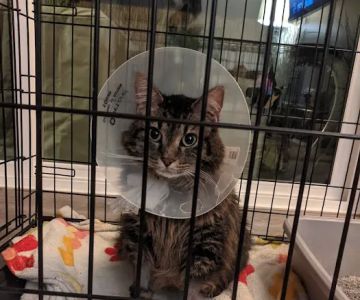How to Care for Pets with Food Allergies: A Complete Guide
- 1. Understanding Food Allergies in Pets
- 2. Recognizing Symptoms of Food Allergies in Pets
- 3. How to Manage and Treat Pet Food Allergies
- 4. Choosing the Right Diet for Pets with Food Allergies
- 5. Real-Life Stories of Managing Pet Food Allergies
- 6. When to Consult a Veterinarian About Food Allergies
1. Understanding Food Allergies in Pets
Food allergies are a common issue for both dogs and cats. Just like in humans, pets can develop allergic reactions to certain ingredients in their food. These allergies are often caused by a pet’s immune system responding to a particular protein or carbohydrate that it mistakenly identifies as harmful.
Some of the most common food allergens for pets include chicken, beef, dairy, soy, corn, and wheat. It's important to understand that food allergies in pets are different from food intolerances, which are more about digestive issues rather than immune system responses. Identifying and managing food allergies properly is essential to ensuring your pet's long-term health and comfort.
2. Recognizing Symptoms of Food Allergies in Pets
The symptoms of food allergies in pets can vary depending on the severity of the reaction and the individual pet. Some of the most common signs include:
1. Skin Problems: Itching, rashes, hot spots, or ear infections are common signs of food allergies in pets. These symptoms occur because allergens can irritate the skin and cause inflammation.
2. Digestive Issues: Pets with food allergies may experience vomiting, diarrhea, or constipation. These digestive problems occur as the immune system responds to the allergens.
3. Respiratory Symptoms: Though less common, some pets may show respiratory symptoms such as coughing, sneezing, or wheezing due to their allergies.
4. Behavior Changes: Pets with food allergies may become more lethargic, irritable, or anxious due to the discomfort they’re experiencing.
3. How to Manage and Treat Pet Food Allergies
Managing food allergies in pets requires a multi-step approach, from identifying the allergens to choosing the right treatment options. Here’s a breakdown of how you can manage your pet’s food allergies effectively:
1. Elimination Diet: One of the first steps in diagnosing and managing food allergies is an elimination diet. This involves removing all potential allergens from your pet’s diet and gradually reintroducing them one by one to identify which ingredients are causing the reaction.
2. Hypoallergenic Pet Food: Once the offending ingredient is identified, your veterinarian may recommend hypoallergenic or limited-ingredient pet food. These foods contain fewer ingredients, making it easier to avoid allergens.
3. Treating Symptoms: In addition to dietary changes, some pets may require medications to manage the symptoms of food allergies. This may include antihistamines or steroids to control itching and inflammation. Always consult your veterinarian before giving your pet any medication.
4. Choosing the Right Diet for Pets with Food Allergies
When it comes to feeding pets with food allergies, the right diet plays a critical role in their health and well-being. Choosing a food that is both safe and nutritious is essential:
1. Limited Ingredient Diets: Limited ingredient diets are specially formulated with fewer ingredients to help reduce the risk of allergic reactions. These diets often include a single protein source and easily digestible carbohydrates, which can help avoid common allergens.
2. Grain-Free Options: For pets with grain sensitivities, a grain-free diet might be an excellent option. These diets typically use alternative sources of carbohydrates, such as sweet potatoes or peas, to avoid grains like corn and wheat.
3. Novel Proteins: Some pets may be allergic to common proteins like chicken or beef. In these cases, feeding your pet a diet that includes novel protein sources, such as venison, duck, or fish, can help reduce the risk of allergic reactions.
4. Consultation with a Veterinarian: Your veterinarian is the best resource for recommending an appropriate diet for your pet’s specific allergies. They can help guide you in selecting food that meets your pet’s nutritional needs while avoiding allergens.
5. Real-Life Stories of Managing Pet Food Allergies
Real-life experiences can offer valuable insights into how food allergies affect pets and how owners manage them. For example, Sarah, an owner of a Labrador named Buddy, noticed that Buddy was constantly scratching and had dry, flaky skin. After a visit to the vet, they discovered that Buddy had a sensitivity to chicken. By switching to a limited-ingredient diet with a novel protein source like venison, Buddy’s skin condition improved dramatically, and the itching subsided.
Similarly, Lisa, who owns a cat named Momo, struggled with constant digestive issues in Momo, such as vomiting and diarrhea. After conducting an elimination diet, they found that Momo was allergic to grains. By switching Momo to a grain-free diet, her symptoms cleared up, and she became more active and playful again.
6. When to Consult a Veterinarian About Food Allergies
If you suspect that your pet has food allergies, it’s important to consult a veterinarian for guidance. A veterinarian can help you determine the exact cause of your pet’s symptoms and recommend the most effective course of treatment.
If your pet is experiencing severe symptoms, such as difficulty breathing, severe vomiting, or swelling, seek emergency veterinary care immediately. Allergic reactions can sometimes become life-threatening, and it’s always better to err on the side of caution.
For ongoing care, regular follow-up visits to the vet are essential to monitor your pet’s condition and make any necessary adjustments to their diet or treatment plan.
Looking for high-quality food and products for pets with food allergies? Visit Hidden Brook Veterinary for expert recommendations on the best pet food, treats, and allergy management solutions to keep your furry friend happy and healthy.











